State and local farmland preservation programs have existed throughout the United States since the late 1970s to slow the conversion of agricultural lands to other uses. These programs take two basic forms, either purchase of development rights/purchase of agricultural conservation easements (PDR/PACE), or transfer of development rights (TDR). They result in an easement becoming attached to the agricultural land that restricts the right to convert the land to residential, commercial, and industrial uses. The landowner is provided with a cash payment and/or tax benefit for participation.
Preservation programs are motivated by a number of policy objectives, including: local and national food security; viability of the local agricultural economy; efficient development of urban and rural land; and the protection of rural and environmental amenities (Gardner; Hellerstein et al.; Gale). More than 124 governmental entities in the United States have implemented farmland preservation programs and over 1.67 million acres are now in preserved status at a cost of almost $4 billion (American Farmland Trust 2005a, 2005b). Citizens continue to pass ballot initiatives to generate the funds to purchase easements.
While there is some evidence that preservation programs provide net benefits to society (Feather and Barnard; Duke and Ilvento), little evaluation has beenconducted on their impact on farmland prices or farmland retention. Economic theory predicts that an agricultural easement will reduce the sales price of a farm. Therefore, it was surprising when Nickerson and Lynch, using sales data for 223 farms (20 with easements) in Maryland during 1994–1997, found little evidence that easement restrictions affect sales price.
In this paper, we re-examine the impact of agricultural easements on sales prices, using a substantially expanded data set of 3,554 observations in 22 Maryland counties, including 249 preserved properties over 1997–2003. Maryland has had a variety of state and county agricultural land preservation programs since the late 1970s, with almost 250,000 acres preserved by 2004 in the state Maryland Agricultural Land Preservation Foundation (MALPF) program.1 We analyze the impact of agricultural easements on sales prices, using both hedonic regression and propensity score approaches.





